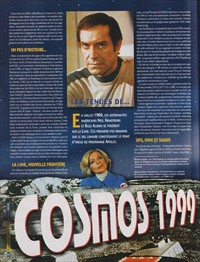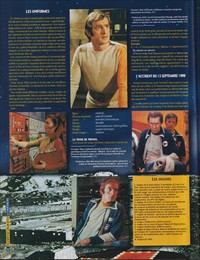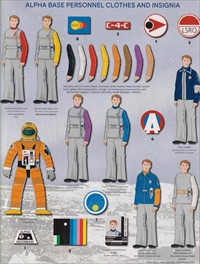Collecting press
Dixième Planète
Dixième Planète ("10th planet") was a glossy French magazine for collectors of film and TV related merchandising. It started in 1999, the first issue coinciding with the release of Star Wars The Phantom Menace, and would run for 9 years, with 51 issues and 11 special editions (hors série), ending in 2008.
The editor was Erwan Le Vexier, who took many of the photographs of merchandising; writers included Jean-Marc Deschamps. Later issues, probably influenced by UK magazine Sci-Fi & Fantasy Models, increasingly focussed at model replicas and original filming models, with notable issues including the second hors série (special edition) on 2001, and hors série 4, on film SFX.
Cosmos 1999 ("Space 1999") was covered in the first issue (October-November 1999), with Landau on the cover alongside Star Wars, and in issue 28 (April-May 2004, with an Eagle joining Hellboy and Starsky and Hutch on the cover). Thunderbirds was on the cover of issue 13 (October-November 2001).
The article in issue 1, on pages 80-84 and was written by Jean-Christophe Carbonel, who had written articles about the series model kits for the UK magazine Collecting Scale Models (1991), and for Sci-Fi & Fantasy Models #39 (September 1999). He wrote several books in French, and some English editions, on model kits and figures from Airfix, Revell, Esci, Matchbox and Heller, plus real-world aircraft. The costume artwork was by Andre Jouineau, closely based on Anthony Fredrickson costume art in the Moonbase Alpha Technical Notebook (1977). Jouineau specialises in historical military uniforms and insignia.
While the magazine focussed on merchandising, this and a few other articles were general articles, with this a fictional history of the Moonbase costumes and organisation. Admittedly merchandise was very limited in France (Dinky, Airfix), although Alain Carrazé had included a nice pictorial guide in his article in Télé Séries #9 (1987).
The Technical Notebook leads the author and artist to take "un mauvais tournant" (wrong turn) because it uses the American English "khaki" for the uniform colour, rather than the British English/French "beige" (originally meaning the colour of undyed wool, which is what the uniforms were made of). This was before the DVDs, let alone the high definition Blu-ray versions, so the base colour of the uniforms is assumed to be grey.





This is an English translation.
The Outfits Of Space: 1999
In July 1969, the American astronauts Neil Armstrong and Buzz Aldrin landed on the moon. These first human steps on lunar soil constituted the culmination of the Apollo program.
However, NASA was thinking about the future. Indeed, several paths were then possible: occupation of low Earth orbits with the development of a reusable vehicle of high useful cargo capacity was a key focus, human exploration of the solar system, or even permanent occupation of the Moon. Given the budgetary problems created by the Vietnam War and the fact that the political objective (going to the Moon before the Soviets) had been achieved, these hopes were particularly ambitious.
A Little History...
But an extraneous event greatly influenced the final choice. In 1970, Colonel Edward Straker of the US Air Force submitted to the International Astrophysics Commission (IAC) of the UN a report prepared at the initiative of General Henderson, proving the reality of the UFO phenomenon and its involvement in unexplained disappearances in the USA, England, South America, and throughout the world. The IAC, on the basis of this report, decided to set up a paramilitary force whose role would be to investigate UFOs and intercept them as soon as they violated human space. This force was called SHADO, Supreme Headquarters Alien Defence Organization and organized on the model of NATO military forces (S.H.A.P.E.). Influenced by the American Army, whose "Horizon" project for a military lunar base had been rejected by the American Congress in the early sixties, and supported by it, the IAC decided to build a military lunar base. This base, built entirely from prefabricated modules brought from Earth, could be built in a few years without requiring the development of a heavy shuttle. Thus, NASA found external funding for the continuation of its lunar program while it could concentrate its own investments on distant exploration. A fully recoverable two-stage shuttle, but of low tonnage, was nevertheless developed to resupply the lunar base, while space interceptors were designed for deployment on this base.
The Moon, A New Frontier
Furthermore, it was decided to open the Moon to private investment and, conversely, to prohibit any national military presence. The SHADO lunar base was therefore a UN enclave and not an American possession. However, American (and to a lesser extent European) influence on the UN space program remained significant.
The Soviets soon opened a base for mineral exploration, and a few companies also installed lunar exploration units. However, it is notable that no major company invested directly on the Moon, preferring to create ad hoc subsidiaries to do so. A typical example of this method was, for example, the creation of Dalotek Inc. by one of the major American technology groups. Although linked to the famous "military-industrial complex," this group preferred to consolidate its space efforts within an independent entity
Due to the importance of this international space program, an International Lunar Finance Commission was established during the 1970s to control and plan operations concerning the Moon
The SHADO lunar base became operational in the late 1970s (1977?). In 1981, some of the previous projects were reactivated under the authority of IILFC, leaving NASA and its Soviet counterpart only responsibility for scientific exploration programs, which they carried out very well. Thus, the development of Earth's space territory was placed under the aegis of an international organization, thus making it possible to maximize and optimize available resources, while space exploration, a competitive field, remained within national spheres of activity, mainly represented by NASA, Interkosmos, and the European Space Exploration Program. An International Space Academy was also formed to train future astronauts.
UFO and SHADO
There is no doubt that this bout of "internationalism" originated from the 1981 UFO wave, which showed the limits of a limited force like SHADO. Also, as early as 1982, it was decided to build a large lunar base, officially for scientific purposes but with significant defensive potential. Unlike the small base previously built for SHADO, this new facility would emphasize its scientific research aspects and would be open to the public. This would thus avoid the paranoia and the "secret service" aspect which had harmed the full effectiveness of SHADO by imposing a discretion which was difficult to maintain and by stressing the staff enormously (one can judge the extent of the problem by considering that the Medical Director of SHADO, Doctor Doug Jackson, was a psychoanalyst by training, a former dissident chess champion who had gone to the West. Moreover, the tests at the discretion of SHADO (hidden vehicles, no official establishment), coupled with the official denial of the UFO phenomenon since 1968, had above all contributed to the increase in the circulation of the sensational press and to discrediting government efforts in the field of space defence.
In 1983, work began on building the Alpha 4 Lunar Station in the Plato crater on the near side of the Moon. This choice was officially made for ease of communication, but there is no doubt that the psychological aspect of the reassuring presence of Earthlight for future "alphans" also influenced this choice. However, internationalism, while fashionable in space, was hardly applied on Earth, and on the contrary, tensions arising from a revival of nationalism culminated caused by a thermonuclear bomb attack that devastated Switzerland in 1987
The consequences of this attack, which was never claimed but was attributed to a separatist group, were colossal, and not only at the national level: in fact, the future commander of the Alpha base lost his wife, who was on vacation in Switzerland at the time. A disarmament conference was held, which for once bore fruit: all nuclear weapons from all countries were to be dismantled and the warheads and their fissile material stored in a specific site on the far side of the Moon, the Nuclear Waste Disposal Area. Conversely, the national or commercial initiatives that had enabled lunar settlements withdrew from the game, preferring to concentrate their efforts on Earth for private firms, while states preferred to rely on the International Alpha Base.
We Lived On The Moon
In 1992, the first phase of construction of Alpha Base was completed and entered operation. Perfectly synchronized, the new generation of space shuttles, optimized for lunar flight, was also put into service that year. These vehicles replaced the two-stage recoverable version previously used and were named "Eagles." They were modular aircraft on which the aerodynamic fairing had been sacrificed in favour of a semi-geodetic structure containing the thrusters, their tanks, and auxiliary systems. Only the pilot module was pressurized, but a habitable module could be carried.
In May 1994, a second Nuclear Waste Repository was opened, and the first was ceased to be used (but not monitored).
It wasn't until September 1996 that testing of the Hawk Mk IX, the defence-optimized equivalent of the Eagle, began. This aircraft, which shared 70% of the same elements as the Eagle (particularly the avionics, life support systems, and the entire pilot module), was eventually to replace the interceptors that had served during the campaign against UFOs 15 years earlier.
On February 17, 1999, Moon Base Alpha was inaugurated and became fully operational.
On September 9, the first commander of the completed base took office: Commander John Koeniq. On September 11, a chain reaction occurred in Disposal Zone 1, which exploded on September 13, tearing the Moon from its orbit
2,416 days (the lunar base's internal calendar) later, Alpha Base ceased broadcasting on all frequencies. Its trace remains lost to this day...
Sources
- Alpha Moonbase Technical Notebook by D. Hirsch, G. Mandel, D. McConnell with A. Fredrikson for the costumes. Published by Starlog Press, 1980
- UFO Annual 1970
- Space 1999 Annual 1974, 1975, 1976
- Space 1999 Town Mook, 1981
- UFO Town Mook, 1981
- Starlog No. 7, 1977
- Various episodes of UFO and of Space 1999
The Uniforms
In keeping with the civilian character of the base, it was decided that the uniforms would be as user-friendly and non-military in appearance as possible. A soft, non-aggressive beige colour (called khaki, but the Anglo-Saxon khaki is a beige, unlike the French khaki, which is olive-coloured French and British English have the same meaning for "Khaki", but in American English it is a light tan, and that's used in the Technical Notebook) was chosen as the general shade of the uniforms. Designed as indoor outfits, these costumes consisted of wide-legged trousers (a style known as "bell-bottoms") and a long-sleeved jersey. Everything was also made of synthetic fabric closed with zips.
A belt and plastic-coated boots in a slightly darker shade completed the outfit. The belt held the device known as a commlock (serving as both an access card and a communications system) and the identification plate. As a result, the pockets could be reduced to their simplest form (inside sleeve pockets for small personal items).
This outfit was worn by both male and female base personnel, as well as visitors.
To avoid any military reference, no rank insignia appeared. Only the base commander was distinguished by the addition of a coloured collar to his outfit. However, the right sleeve was used to identify the speciality or field:
- Black
- command
- White
- medical
- Flame (scarlet)
- control room
- Yellow
- data (computers)
- Mauve
- security
- Orange
- reconnaissance (astronauts)
- Rust
- technical support
- Khaki (beige)
- visitors
The Work Clothing
A similarly cut suit, but without the sleeves. This gray colour served as workwear. This outfit bore, on the left side of the chest, a rectangle indicating the section to which it belonged in three characters. Example:
C-4-C Command, Sector 4, Department C OFF DUTY This is based on the VJC insignia seen on pyjamas and some jacketsThe beige outfit was frequently worn outside of working hours, proof that the objective of designing comfortable clothing had been achieved. However, non-regulation shoes appeared at these times, which seems to suggest a deficiency in the design.
The Accident Of September 13, 1999
During the year following the accident that threw the Moon out of orbit, Dr. Russell diagnosed several cases of stress, which were understandable, but which led him to rethink the base's working environment and seek ways to improve staff morale.
One of the points that was raised was the general coldness of the base's interior. It was decided that although it was difficult to review the station's internal architecture (it was made of mass-coloured plastic), especially since, for security reasons, it had been decided to relocate certain strategic sectors of the base to the lower floors, beneath the lunar surface, it was possible to change the clothing worn by the personnel.
The absence of pockets having been criticized, it was decided to provide each person with a jacket in a colour corresponding to their sector of activity. Experience had also shown that, given the small number of people involved (at full strength, the Alpha base comprised 311 people), the original colour code palette could also be reduced. From the second year of wandering, the code was reduced as follows:
- Gray-blue
- Command
- Royal blue
- science and medical
- Flame (scarlet)
- exploration
- Yellow
- Data (IT)
This is invented- the second series retained the original colours from the first year - but perhaps the gray-blue is influenced by photos of the actual Koenig costumes, which were never black as they appeared on screen.
In addition, skirts (beige) were introduced for female personnel. Finally, the wearing of badges from previous missions or decoration symbols was authorized and even encouraged. The most common were those of LSRO (Lunar & Space Research Organization), the scientific entity on which the base depended (IILFC being the administrative entity), ESEP, and ANC (American Nuclear Commission), the organization responsible for managing NWDA 1 & 2 on behalf of IILFC.
Alpha Base Personnel Clothes And Insignia


The illustrator is misled by the Technical Notebook's "khaki" for visitors, which should be the same beige as the rest of the uniform (rendered grey here, as it appeared on screen). There was never a blue sleeve ("science and medical departments"). The Alphan badge for "J M Moonghin" refers to magazine editor Jean-Marie Mongin, who elsewhere in this issue does a similar article on Star Trek insignia. The female id, "A D Coolberth" is writer Anne de Colbert.
Exploration Clothing
Given the initially unplanned exploration work that the personnel would have to carry out due to the events, a flexible jacket was made of plastic fabric to protect ground personnel. This jacket was colour-coded like the vest and bore the usual badges. Exploration boots, reinforced compared to standard boots, were also introduced
Winter Outfit
A few examples of a heat-insulated winter outfit incorporating a hood, protective goggles, and a woollen undergarment were produced for the exploration of icy planets. These outfits, bright blue with red piping (they had been designed by the medical department for the exploration department), were little used.
The Pressure Suit
The spacesuit used by Alphan personnel on the lunar surface is derived from the EVS-3 model used by SHADO. It is designed for short-term use (less than 24 hours) and consists of a set of protective layers onto which boots, gloves, and a helmet are clipped. The outer layer is silver, but a bright orange plastic-coated fabric covering is worn over the spacesuit itself to improve the astronauts' visibility on the lunar surface. Pressurized oxygen tanks are worn on the back, and a kit containing batteries, lighting, heating, GPS, etc. is attached to the chest. Most of the equipment controls are on the wrists. The Alpha base insignia is worn on each shoulder, and the Unified Earth flag (this flag is only valid in space, since there is no unified government on Earth) is worn on the left arm. The spacesuits, being adjusted to the measurements of their wearer, are named; the name is worn on the helmet, above the visor.
Equipment
Two main pieces of equipment are used by Alpha personnel: the Stun Gun and the Commlock
The Stun Gun is a weapon-tool combination with four barrels: barrel 1 projects a paralysing discharge (the model for officers and security services allows for high-power adjustment of these emissions, which can then kill a human being); tube 2 emits a torch beam with a diameter of one micron used as a cutting and welding tool on plastic and metal sheets; tube 3 emits a more intense beam capable of acting on rock or thick metal; tube 4 diffuses broadband disruptive radiation, allowing the disintegration of the target (wearing a protective suit is recommended when using tube 4).
The Commlock serves as an electronic key (configured according to the owner's access level), a GSM phone, and a communications terminal. In this last function, it has three modes: videophone, remote terminal for the base's computer system and calculator.